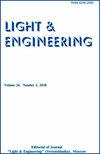A Model for Evaluating the Visual Perception of an Arbitrary Distribution of Luminance in Indoor Lighting Installations
IF 0.3
4区 工程技术
Q4 ENGINEERING, ELECTRICAL & ELECTRONIC
引用次数: 0
Abstract
How to assess what kind of feeling the lighting scene causes? A new level of computer graphics visualization makes it possible to think about real image through synthetic images from one hand, and from other hand, today the HDRi method allows fixing luminance with an accuracy of up to 10 % in a wide range. Therefore, assessing the lighting quality of designed and existing lighting installations in terms of luminance reaches a new level. It brings the creating of psychophysical model of lighting quality assessment through photometric quantities closer. The structure of the model can be represented in two parts: the calculation equation and the psychophysical scale. This work considers the issue of choosing categories of the psychophysical scale, the method of creating of luminance maps for scene with an arbitrary spatial angle luminance distribution, and the method for evaluating scenes using a new gradient criterion Q based on these maps. An analysis of HDRi images of workplaces based on the experimental setup and scenes in a cafe showed that the Q criterion depends on the type of scene and on the number of light sources in the field of view. One could suggest that it is impossible to create one single psychophysical scale for the Q criterion. However, one can use this new criterion to evaluate the same scenes with different lighting options or similar scenes in terms of spatial luminance distribution and glare. Despite of the luminance map values have an error of about 30 % the using HDRi image of scene allows to calculate Q criterion with an accuracy of about 10 %.室内照明装置中任意亮度分布的视觉感知评估模型
如何评价灯光场景给人的感觉?一个新的计算机图形可视化水平使得人们可以从一方面通过合成图像来思考真实的图像,而从另一方面来看,今天的HDRi方法可以在大范围内以高达10%的精度固定亮度。因此,从亮度角度评估设计和现有照明装置的照明质量达到了一个新的水平。它使通过光度量评价照明质量的心理物理模型的建立更加接近。模型的结构可分为计算方程和心理物理量表两部分。这项工作考虑了心理物理尺度的类别选择问题,为具有任意空间角度亮度分布的场景创建亮度地图的方法,以及基于这些地图使用新的梯度准则Q评估场景的方法。基于实验设置和咖啡馆场景的工作场所HDRi图像分析表明,Q标准取决于场景类型和视场中光源的数量。有人可能会说,不可能为Q标准创建一个单一的心理物理量表。然而,人们可以使用这个新标准来评估具有不同照明选项的相同场景或类似场景的空间亮度分布和眩光。尽管亮度图值有30%左右的误差,但使用场景的HDRi图像可以计算出精度约为10%的Q准则。
本文章由计算机程序翻译,如有差异,请以英文原文为准。
求助全文
约1分钟内获得全文
求助全文
来源期刊

Light & Engineering
ENGINEERING, ELECTRICAL & ELECTRONIC-OPTICS
CiteScore
1.00
自引率
50.00%
发文量
0
审稿时长
1 months
期刊介绍:
Our magazine
develops comprehensive communication within the lighting community, providing opportunities for discussion and free expression of opinions of specialists of different profiles;
contributes to the convergence of science and engineering practice, the search for opportunities for the application of research results in lighting and technological applications of light;
keeps the scientific community up to date with the latest advances in the theory of the light field, providing readers with operational professional information;
initiates international cooperation, promotes and distributes the results of Russian authors in the international professional community;
provides equal opportunities for authors from different regions of Russia and other countries.
The journal publishes articles in the following areas:
visual and non-visual effects of radiation on humans;
light field theory;
photometry and colorimetry;
sources of light;
ballasts;
light devices, their design and production technology;
lighting and irradiation installation;
light signaling;
methods of mathematical modeling of light devices and installations;
problems of energy saving in lighting, installation and operation of lighting installations;
modern production technologies of lighting products for lighting control systems;
innovative design solutions;
innovations in lighting and lighting design;
the study of the effect on plants and animals, problems of using light in medicine;
problems of disinfection of premises, water and smell elimination with the help of technology of UV radiation using;
problems of light in the ocean and space.
 求助内容:
求助内容: 应助结果提醒方式:
应助结果提醒方式:


